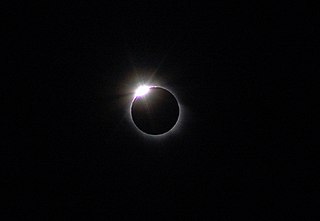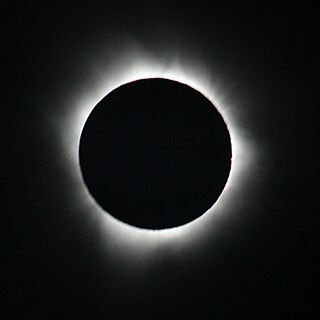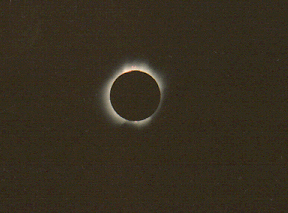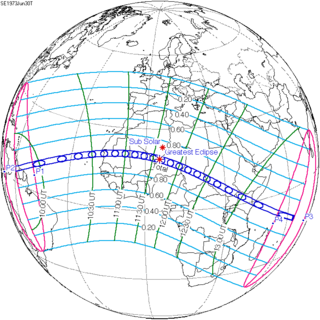Related Research Articles

A total solar eclipse occurred at the Moon’s ascending node of orbit on Wednesday, March 29, 2006, with a magnitude of 1.0515. A solar eclipse occurs when the Moon passes between Earth and the Sun, thereby totally or partly obscuring the image of the Sun for a viewer on Earth. A total solar eclipse occurs when the Moon's apparent diameter is larger than the Sun's, blocking all direct sunlight, turning day into darkness. Totality occurs in a narrow path across Earth's surface, with the partial solar eclipse visible over a surrounding region thousands of kilometres wide. Occurring about 1.1 days after perigee, the Moon's apparent diameter was larger.

Fred Espenak is a retired emeritus American astrophysicist. He worked at the Goddard Space Flight Center. He is best known for his work on eclipse predictions.

A total solar eclipse occurred at the Moon’s ascending node of orbit on Wednesday, August 11, 1999, with a magnitude of 1.0286. A solar eclipse occurs when the moon passes between earth and the sun, thereby totally or partly obscuring the image of the sun for a viewer on earth. A total solar eclipse occurs when the moon's apparent diameter is larger than the sun's, blocking all direct sunlight, turning day into darkness. Totality occurs in a narrow path across earth's surface, with the partial solar eclipse visible over a surrounding region thousands of kilometres wide. Occurring about 3.5 days after perigee, the Moon's apparent diameter was larger.

The solar eclipse of August 21, 2017, dubbed the "Great American Eclipse" by some media, was a total solar eclipse visible within a band that spanned the contiguous United States from the Pacific to the Atlantic coasts. It was also visible as a partial solar eclipse from as far north as Nunavut in northern Canada to as far south as northern South America. In northwestern Europe and Africa, it was partially visible in the late evening. In northeastern Asia, it was partially visible at sunrise.

A solar eclipse occurs when the Moon passes between Earth and the Sun, thereby obscuring the view of the Sun from a small part of Earth, totally or partially. Such an alignment occurs approximately every six months, during the eclipse season in its new moon phase, when the Moon's orbital plane is closest to the plane of Earth's orbit. In a total eclipse, the disk of the Sun is fully obscured by the Moon. In partial and annular eclipses, only part of the Sun is obscured. Unlike a lunar eclipse, which may be viewed from anywhere on the night side of Earth, a solar eclipse can only be viewed from a relatively small area of the world. As such, although total solar eclipses occur somewhere on Earth every 18 months on average, they recur at any given place only once every 360 to 410 years.

A total solar eclipse occurred at the Moon's descending node of orbit between Sunday, July 11 and Monday, July 12, 2010, with a magnitude of 1.058. A solar eclipse occurs when the Moon passes between Earth and the Sun, thereby totally or partly obscuring the image of the Sun for a viewer on Earth. A total solar eclipse occurs when the Moon's apparent diameter is larger than the Sun's, blocking all direct sunlight, turning day into darkness. Totality occurs in a narrow path across Earth's surface, with the partial solar eclipse visible over a surrounding region thousands of kilometres wide. Occurring about 1.6 days before perigee, the Moon's apparent diameter was larger.

A total solar eclipse occurred at the Moon's descending node of orbit on Thursday, July 11, 1991, with a magnitude of 1.08. A solar eclipse occurs when the Moon passes between Earth and the Sun, thereby totally or partly obscuring the image of the Sun for a viewer on Earth. A total solar eclipse occurs when the Moon's apparent diameter is larger than the Sun's, blocking all direct sunlight, turning day into darkness. Totality occurs in a narrow path across Earth's surface, with the partial solar eclipse visible over a surrounding region thousands of kilometres wide. Occurring about 8 hours after perigee, the Moon's apparent diameter was larger.

An airborne observatory is an airplane or airship with an astronomical telescope. By carrying the telescope to a sufficiently high altitude, the telescope can avoid cloud cover, pollution, and carry out observations in the infrared spectrum, above water vapor in the atmosphere which absorbs infrared radiation. Some drawbacks to this approach are the instability of the lifting platform, the weight restrictions on the instrument, the need to safely recover the gear afterward, and the cost compared to a comparable ground-based observatory.

A total solar eclipse occurred at the Moon's descending node of orbit on Saturday, June 30, 1973, with a magnitude of 1.0792. A solar eclipse occurs when the Moon passes between Earth and the Sun, thereby totally or partly obscuring the image of the Sun for a viewer on Earth. A total solar eclipse occurs when the Moon's apparent diameter is larger than the Sun's, blocking all direct sunlight, turning day into darkness. Totality occurs in a narrow path across Earth's surface, with the partial solar eclipse visible over a surrounding region thousands of kilometres wide. Occurring about 11 hours after perigee, the Moon's apparent diameter was larger.

A total solar eclipse occurred at the Moon's ascending node of orbit on Tuesday, October 24, 1995, with a magnitude of 1.0213. A solar eclipse occurs when the Moon passes between Earth and the Sun, thereby totally or partly obscuring the image of the Sun for a viewer on Earth. A total solar eclipse occurs when the Moon's apparent diameter is larger than the Sun's, blocking all direct sunlight, turning day into darkness. Totality occurs in a narrow path across Earth's surface, with the partial solar eclipse visible over a surrounding region thousands of kilometres wide. Occurring about 2.7 days before perigee, the Moon's apparent diameter was larger.

A total solar eclipse occurred at the Moon's ascending node of orbit on Saturday, June 11, 1983, with a magnitude of 1.0524. A solar eclipse occurs when the Moon passes between Earth and the Sun, thereby totally or partly obscuring the image of the Sun for a viewer on Earth. A total solar eclipse occurs when the Moon's apparent diameter is larger than the Sun's, blocking all direct sunlight, turning day into darkness. Totality occurs in a narrow path across Earth's surface, with the partial solar eclipse visible over a surrounding region thousands of kilometres wide. Occurring about 2.1 days before perigee, the Moon's apparent diameter was larger.

A total solar eclipse occurred at the Moon's descending node of orbit on Friday, October 3, 1986, with a magnitude of 1. It was a hybrid event, with only a fraction of its path as total, and longer sections at the start and end as an annular eclipse. A solar eclipse occurs when the Moon passes between Earth and the Sun, thereby totally or partly obscuring the image of the Sun for a viewer on Earth. A total solar eclipse occurs when the Moon's apparent diameter is larger than the Sun's, blocking all direct sunlight, turning day into darkness. Totality occurs in a narrow path across Earth's surface, with the partial solar eclipse visible over a surrounding region thousands of kilometres wide. The Moon's apparent diameter was near the average diameter because it occurred 8.3 days after apogee and 3.7 days before perigee.

A total solar eclipse occurred at the Moon's ascending node of orbit on Wednesday, August 30, 1905, with a magnitude of 1.0477. A solar eclipse occurs when the Moon passes between Earth and the Sun, thereby totally or partly obscuring the image of the Sun for a viewer on Earth. A total solar eclipse occurs when the Moon's apparent diameter is larger than the Sun's, blocking all direct sunlight, turning day into darkness. Totality occurs in a narrow path across Earth's surface, with the partial solar eclipse visible over a surrounding region thousands of kilometres wide. Occurring about 1.9 days before perigee, the Moon's apparent diameter was larger.

A total solar eclipse occurred at the Moon's descending node of orbit on Monday, May 28, 1900, with a magnitude of 1.0249. A solar eclipse occurs when the Moon passes between Earth and the Sun, thereby totally or partly obscuring the image of the Sun for a viewer on Earth. A total solar eclipse occurs when the Moon's apparent diameter is larger than the Sun's, blocking all direct sunlight, turning day into darkness. Totality occurs in a narrow path across Earth's surface, with the partial solar eclipse visible over a surrounding region thousands of kilometres wide. Occurring about 3.9 days after perigee, the Moon's apparent diameter was larger.

A total solar eclipse occurred on June 24, 1778. A solar eclipse occurs when the Moon passes between Earth and the Sun, thereby totally or partly obscuring the image of the Sun for a viewer on Earth. A total solar eclipse occurs when the Moon's apparent diameter is larger than the Sun's, blocking all direct sunlight, turning day into darkness. Totality occurs in a narrow path across Earth's surface, with the partial solar eclipse visible over a surrounding region thousands of kilometres wide.

A total solar eclipse occurred on May 22, 1724. A solar eclipse occurs when the Moon passes between Earth and the Sun, thereby totally or partly obscuring the image of the Sun for a viewer on Earth. A total solar eclipse occurs when the Moon's apparent diameter is larger than the Sun's, blocking all direct sunlight, turning day into darkness. Totality occurs in a narrow path across Earth's surface, with the partial solar eclipse visible over a surrounding region thousands of kilometres wide.

Eclipse chasing is the pursuit of observing solar eclipses when they occur around the Earth. Solar eclipses must occur at least twice and as often as five times a year across the Earth. Total eclipses may occur multiple times every few years.

The solar eclipse on May 12, 1706 was a total eclipse.
On 30 June 1973, the supersonic jet Concorde 001 intercepted the path of a total solar eclipse and followed the path of totality as it crossed Africa. This feat allowed the passengers to experience a total solar eclipse for 74 minutes, the longest-ever total eclipse observation. Five experiments were carried out during the flight, but they have had limited scientific impact.
References
- 1 2 3 4 5 6 7 8 Koren, Marina (21 August 2017). "The King of Totality". The Atlantic. Retrieved 24 September 2018.
- 1 2 3 Greenfieldboyce, Nell (8 August 2017). "Go See It, Eclipse Chasers Urge. 'Your First Time Is Always Special'". NPR. Retrieved 24 September 2018.
- ↑ Stephenson, Lauren; Seales, Chance (18 August 2017). "Meet The Man About To Witness His 27th Total Solar Eclipse". ABC Action News WFTS. Newsy. Retrieved 24 September 2018.
- 1 2 3 4 5 6 LaFleur, Elizabeth (27 April 2017). "Watch the eclipse and be 'amazed' like this guy who's seen 26 of them". Greenville News. Retrieved 24 September 2018.
- 1 2 Borenstein, Seth (17 August 2017). "Chasing eclipses across the globe is a way of life for some". The Post and Courier. Retrieved 24 September 2018.
- ↑ "Liebenberg's research shines more light on coronal emissions during total solar eclipses". Clemson Newsstand. 12 March 2019. Retrieved 8 July 2019.
- ↑ Mulkin, Barb. "In Flight: The Story of Los Alamos Eclipse Missions". Los Alamos Science. Retrieved October 21, 2018.
- ↑ Meeus, J (2003). "The maximum possible duration of a total solar eclipse". Journal of the British Astronomical Association. 113: 344 (Table 1). Bibcode:2003JBAA..113..343M . Retrieved 25 September 2018.
- ↑ Melvin, Jim. "26 AND COUNTING / The Liebenberg Chronicles / Eclipse 9 / Part 2 of Concorde flight". The Newsstand – Clemson University. Retrieved 24 September 2018.